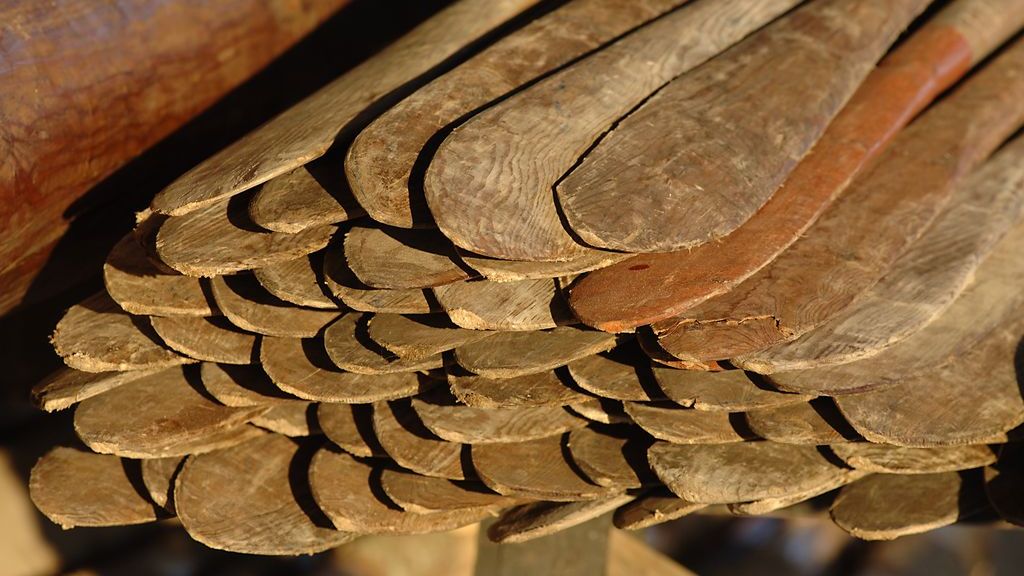With the inscription of Nordic clinker boat traditions on UNESCO’s representative list of the intangible cultural heritage of humanity, the international society has acknowledged that the building and use of Nordic clinker-built boats should be preserved for the future.
This also means that Nordic clinker boat traditions have been incorporated into a wider context as a part of the intangible cultural heritage of humanity.
A tradition that has left its mark
For thousands of years, the clinker-built boats of the North have provided the framework for Nordic peoples’ connections to the waters surrounding them.
In small dinghies, the coastal fishermen provided for their families, and in large ships, contacts were established and secured along the coasts and across the endless seas.
For generations, the boats have connected Nordic people from coast to coast, drawn the North out into the wider world and ferried that wider world back into the North.
The light, strong and swift ships of the Vikings were unsurpassed in their time. Those ships provided the foundation for the Scandinavian kingdoms.
The large, ocean-going ships made it possible to settle the North Atlantic area, to raid, conquer and establish trading routes from the far north to the Mediterranean.
Ancient methods still in use today
In the North – both before and after the Viking Age – wooden boats have been built using a particular technique, which is characterised by the way in which the longitudinal planks overlap each other at their outer edge, where they are either sewn or riveted together. The boat is then strengthened internally by additional wooden components, which constitute the ribs of the vessel.
This method is known as clinker-building and in Europe, it is only in the North that the tradition of building boats using this method is still in use.
Clinker-building has dominated the Nordic boat tradition since the first boats with planked sides were built, thousands of years ago.
During that time span, countless clinker-built boats have been constructed, both for fishing and for the transport of people and goods.
Across time, the boatbuilders have worked without the aid of construction drawings. Rather, they have built boats based on their own experience, knowledge that has been handed down through the generations and in collaboration with the boat’s future owner, so that each vessel is specifically suited to its intended use and environment.
What makes this so unique is the fact that today, throughout the North, wooden boats are still being built using the same ancient clinker-building technique – though not in anything like the same numbers, as the amount of clinker-built boats has fallen drastically during recent years.
The people who live by building and using these boats are also becoming fewer in number and without them, we risk losing the skills necessary to keep the traditions alive.
Active maritime milieus
In Denmark, however, there are still many active maritime milieus associated with the clinker-built boat.
At the Viking Ship Museum in Roskilde, five Viking ships, which were built in the Nordic clinker-building tradition almost 1,000 years ago, are exhibited.
“They’re the only ships in our collection that are never going to sail again”, tells Søren Nielsen, from the Viking Ship Museum. “In our Museum Harbour, we have ca. 30 clinker-built boats, which we use in dissemination. These boats must be sailed, used and worn until they need to be replaced, so that we can build a new one. In this way, we can keep the tradition alive. You can’t maintain living cultural heritage without doing that: build ships and use them”, explains Søren.
All summer long, school children row and sail out from the Viking Ship Museum’s harbour in the traditional wooden boats and have their – perhaps – first ever experience with sailing and outdoor pursuits. Visitors from all over the world take part in sailing trips, giving them an insight into the connection we in the North still have with the sea.
In north Jutland, fishermen still haul their clinker-built coasters up onto the beaches after fishing and at the boatyards, experienced boatbuilders are handing their knowledge about building and maintaining the traditional boats down to the next generation.
Luckily, many older wooden boats have been preserved and are sailed by passionate mariners. Træskibs Sammenslutningen in Denmark numbers some 500 older working boats, roughly half of which are clinker-built. They contribute to an active maritime milieu connected to these boats, a network, which stretches across the Nordic countries.
Strong communities
Another special aspect of these clinker-built boats is the many places in which strong volunteer communities have been established. For example, several hundred people are members of the Viking Ship Museum’s Boat Guild, which takes care of the regular maintenance of the boats and ships but which also, more importantly, gather to use and sail these vessels for outdoor pursuits and as a way of experiencing nature.
The communities around the clinker-built boats are of vital importance for keeping the wooden boats traditions alive. When these beautiful boats are used, a process is set in motion, which breathes life into the specialised craftwork connected to the boats: sailmakers, ropemakers and boatbuilders, who can keep their skills honed by repairing old boats or building new vessels, by sewing sails and making rope for the rigging.
“There is a great worth in keeping clinker-building traditions alive as they are still relevant for many people today”, says Søren Nielsen from the Viking Ship Museum. “The clinker-built boats give us opportunities that are becoming more and more difficult to find in the world we live in today. They create both a connection to our common past and a present-day framework within which we can experience nature in an environmentally-friendly and sustainable way. With these boats, and as part of this community, you can contribute to the development of the tradition while also safeguarding it for the future”, concludes Søren Nielsen from the Viking Ship Museum.
Inscription comes with obligation - and recognition
The inscription of Nordic clinker boat traditions on UNESCO’s list of the intangible heritage of humanity should lead to an increased focus on the preservation of the knowledge associated with the tradition, craftwork and use of the clinker-built boat.
And inscription on the list comes with obligation. In applying for inscription, all of the Nordic countries have promised to safeguard living maritime cultural heritage for future generations. With this obligation comes international recognition and exposure, which will contribute to keeping the traditions alive.
“I am very happy that the application to have Nordic clinker boat traditions recognised, of which we are signatories, has been accepted. The clinker-built boat in the North is a central part of our living cultural heritage. Throughout time, the boats have been used as vital element of fishing and farming, cargo transport and seafaring, and they are still being built today” states Minister of Culture, Ane Halsboe-Jørgensen.
Inscription means that the international society has acknowledged that Nordic clinker boat traditions are an important part of the intangible cultural heritage of humanity, which must be preserved for the future.
FACTS:
Who is responsible?
This is the first time that UNESCO has received a nomination from a united North.
All of the Nordic countries are responsible for the application to have the Nordic clinker boat traditions inscribed on UNESCO’s list of the intangible cultural heritage of humanity, and all of the Nordic Ministers of Culture have signed the nomination.
The initiative for the UNESCO project was taken by the network ‘Nordisk Kystkultur’, who have ensured that the project was anchored in all of the countries; Denmark, Iceland, the Faroe Islands, Norway, Sweden, the Åland Islands and Finland.
The Norwegian association, Forbundet KYSTEN have co-ordinated the application.
In Denmark, Han Herred Havbåde, Træskibs Sammenslutningen, the Viking Ship Museum in Roskilde, together with local wooden boat milieu, have carried out the work to ensure a place for clinker boat traditions on UNESCO’s list of intangible cultural heritage.
What obligations do the participating states have? All of the Nordic countries have ratified UNESCO’s convention on the safeguarding of intangible cultural heritage and ratification comes with a series of obligations. For examples, each state must take the necessary measures to ensure the protection of intangible cultural heritage existing within their territories, through participation from local communities, groups and other relevant non-state organisations, in order to ensure the viability of the intangible cultural heritage through identification, documentation, research, preservation, protection, promotion, improvement, transfer and education, as well as reviving the many aspects of this heritage.
Info about the UNESCO inscription: Inscription of the Nordic clinker boat traditions on UNESCO’s list shall ensure exposure and awareness concerning the importance of preserving clinker boat traditions.
Inscription follows up on UNESCO’s 2003 convention on the protection of intangible cultural heritage, which all of the Nordic countries have signed.
Dansk Folkemindesamling, at the Royal Library manages Denmark’s work with UNESCO’s 2003 convention for the safeguarding of intangible cultural heritage.
![[Translate to english:] UNESCO anerkender klinkbådstraditioner [Translate to english:] UNESCO anerkender klinkbådstraditioner](/frontend/_processed_/2/3/csm_2008_07_14_21_51_40_3312_unesco_4f33fa0b41.jpg)



![[Translate to english:] UNESCO anerkender klinkbådstraditioner [Translate to english:] UNESCO anerkender klinkbådstraditioner](/frontend/_processed_/2/4/csm_2020_06_17_13_54_41_WK_9692761040.jpeg)
![[Translate to english:] UNESCO anerkender klinkbådstraditioner [Translate to english:] UNESCO anerkender klinkbådstraditioner](/frontend/_processed_/4/6/csm_2020_09_24_12_45_56_WK_58ad0488f5.jpeg)
![[Translate to english:] UNESCO anerkender klinkbådstraditioner [Translate to english:] UNESCO anerkender klinkbådstraditioner](/frontend/_processed_/d/3/csm_2020_09_18_16_47_43_WK_c203d5ad6b.jpg)
![[Translate to english:] UNESCO anerkender klinkbådstraditioner [Translate to english:] UNESCO anerkender klinkbådstraditioner](/frontend/_processed_/4/d/csm_2005_08_20_12_55_42_unesco_ccaa5e1a95.jpg)
![[Translate to english:] UNESCO anerkender klinkbådstraditioner [Translate to english:] UNESCO anerkender klinkbådstraditioner](/frontend/_processed_/a/4/csm_2017_08_19_12_28_54_unesco_28b5ae81b6.jpg)
![[Translate to english:] UNESCO anerkender klinkbådstraditioner [Translate to english:] UNESCO anerkender klinkbådstraditioner](/frontend/_processed_/2/b/csm_2009_08_14_09_47_19_unesco_e2517bd629.jpg)
![[Translate to english:] UNESCO anerkender klinkbådstraditioner [Translate to english:] UNESCO anerkender klinkbådstraditioner](/frontend/_processed_/2/5/csm_2020_05_26_15_53_25_WK_32f622dfab.jpg)